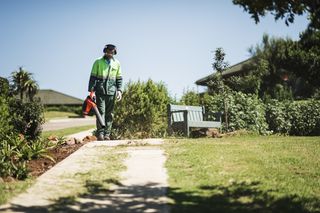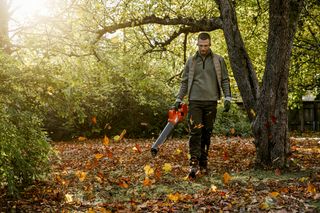
5 ways for using your leaf blower like a pro
Leaf blowers are simple machines that are fairly easy to use, but there are some tricks and techniques that can really make your life so much easier.
Master The Elements
Pick the best time to leaf blow your yard. Respect your neighbours and don’t use any power tools during quiet hours.
It’s very easy to blow dry leaves; wet leaves, not so much. You shouldn’t ever try to clean your garden on a rainy day. The leaves stick to each other and it’s extremely difficult to remove them without having to pick them up yourself.
Wait for the sun to come out and the leaves to dry up. The drier the weather, the better. Remember to not use your leaf blower if you’ve just applied fertilisers, herbicides or pesticides. The chemicals could be scattered into the air, forcing you and your family to inhale them without even realising. It’s always best to leaf blow your garden first and then apply such items.
While leaf blowing, try to work with the wind. Try to feel from which direction the wind is blowing. Doing so will help you direct the leaves away from your garden with less effort. It will also make your leaf blower’s job easier, saving a lot of power in the process.

Divide and Conquer
Don’t even try to blow all the leaves at once. You’ll create a huge mound of leaves that could be blown away with the tiniest breeze. You’ll just be moving piles from one side of your garden to the other—definitely not what you want!
Try to divide your garden into smaller, more manageable sections. You don’t even have to blow everything on the same day. If you have a bigger garden, it might be a good idea to come with a leaf-blowing plan.
Blow the leaves into small piles on each corner of your garden. Try to blow them onto an old sheet or tarp so that it’s easier to later transport them to the garden bin or compost heap.
Begin at one edge of your garden and blow the leaves and debris into a small pile. Make sure you target harder-to-reach areas as well (e.g. bushes, shrubs and trees).
Be precise and consistent. Imagine spending the whole afternoon forming a huge leaf pile in the centre of your garden, only to have the wind scatter everything in a glorious whoosh.
Need for Speed
Blowing leaves from a gravel path is not the same as blowing leaves from a grassy lawn. Take caution when using your leaf blower on harder surfaces, as debris could damage your garden’s perfect look! Speed is nice, but make sure you slow down if you have to.
You need to realise that your garden doesn’t just consist of lawn and leaves. Occasionally full speed might be a choice (e.g. you have a tiny, tidy yard).
Most of the time, however, you’ll be doing your garden more harm than good by exceeding recommended speeds: rocks and dirt flying everywhere, destroyed grass and tears of dread. Treat leaf blowing the same way you would any other garden job. Take your time and do it right; Your lawn will appreciate the effort.
Angle Me Not
Make sure you’re using the right angle. If you don’t take care with the angle, you’ll most likely end up blowing leaves into multiple directions. Dust, dirt and other debris could potentially pose a hazard. Positioning the leaf blower correctly is crucial.
The tip of the leaf blower should always be pointing down. This way air is concentrated into a smaller area, providing you with more blowing control and precision. A shallow angle moves the leaves forward instead of up. Keeping the blower close to the ground also prevents dust from being blown upwards.
Even if your technique is perfect, you’ll never be able to remove all the leaves from your lawn. Don’t let that discourage you, and don’t spend more time than you have trying to get rid of every single leaf. Leaf blowing allows grass to breathe and absorb more water. A few leaves here and there won’t do your lawn harm.

Blown Away
A leaf blower’s main purpose is to, well, blow leaves—and that’s what leaf blowers should be used for.
You can also use your leaf blower to dry your car—Yep! Drying a car after washing can be a hassle, especially during wintertime. A leaf blower will prevent blemishes on your car paint by completely drying its surfaces. Who knew?
That being said, only the most powerful of leaf blowers are fit for such tasks. If you’re looking for a powerful, yet affordable leaf blower that does it all, you should definitely check out the Husqvarna range of blowers today.